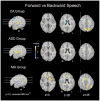Deviant functional magnetic resonance imaging patterns of brain activity to speech in 2-3-year-old children with autism spectrum disorder
- PMID: 18672231
- PMCID: PMC2879340
- DOI: 10.1016/j.biopsych.2008.05.020
Deviant functional magnetic resonance imaging patterns of brain activity to speech in 2-3-year-old children with autism spectrum disorder
Abstract
Background: A failure to develop normal language is one of the most common first signs that a toddler might be at risk for autism. Currently the neural bases underlying this failure to develop language are unknown.
Methods: In this study, functional magnetic resonance imaging (fMRI) was used to identify the brain regions involved in speech perception in 12 2-3-year-old children with autism spectrum disorder (ASD) during natural sleep. We also recorded fMRI data from two typically developing control groups: a mental age-matched (MA) (n = 11) and a chronological age-matched (CA) (n = 12) group. During fMRI data acquisition, forward and backward speech stimuli were presented with intervening periods of no sound presentation.
Results: Direct statistical comparison between groups revealed significant differences in regions recruited to process speech. In comparison with their MA-matched control subjects, the ASD group showed reduced activity in an extended network of brain regions, which are recruited in typical early language acquisition. In comparison with their CA-matched control subjects, ASD participants showed greater activation primarily within right and medial frontal regions. Laterality analyses revealed a trend toward greater recruitment of right hemisphere regions in the ASD group and left hemisphere regions in the CA group during the forward speech condition. Furthermore, correlation analyses revealed a significant positive relationship between right hemisphere frontal and temporal activity to forward speech and receptive language skill.
Conclusions: These findings suggest that at 2-3 years, children with ASD might be on a deviant developmental trajectory characterized by a greater recruitment of right hemisphere regions during speech perception.
Figures





Similar articles
-
A failure of left temporal cortex to specialize for language is an early emerging and fundamental property of autism.Brain. 2012 Mar;135(Pt 3):949-60. doi: 10.1093/brain/awr364. Epub 2012 Feb 20. Brain. 2012. PMID: 22350062 Free PMC article.
-
Maladaptive Laterality in Cortical Networks Related to Social Communication in Autism Spectrum Disorder.J Neurosci. 2022 Nov 30;42(48):9045-9052. doi: 10.1523/JNEUROSCI.1229-22.2022. Epub 2022 Oct 18. J Neurosci. 2022. PMID: 36257690 Free PMC article.
-
Speech perception in autism spectrum disorder: An activation likelihood estimation meta-analysis.Behav Brain Res. 2018 Feb 15;338:118-127. doi: 10.1016/j.bbr.2017.10.025. Epub 2017 Oct 23. Behav Brain Res. 2018. PMID: 29074403
-
Language disorders: autism and other pervasive developmental disorders.Pediatr Clin North Am. 2007 Jun;54(3):469-81, vi. doi: 10.1016/j.pcl.2007.02.011. Pediatr Clin North Am. 2007. PMID: 17543905 Review.
-
Early functional brain development in autism and the promise of sleep fMRI.Brain Res. 2011 Mar 22;1380:162-74. doi: 10.1016/j.brainres.2010.09.028. Epub 2010 Sep 24. Brain Res. 2011. PMID: 20869953 Free PMC article. Review.
Cited by
-
An unbiased Bayesian approach to functional connectomics implicates social-communication networks in autism.Neuroimage Clin. 2015 May 1;8:356-66. doi: 10.1016/j.nicl.2015.04.021. eCollection 2015. Neuroimage Clin. 2015. PMID: 26106561 Free PMC article.
-
Beyond the Spectrum: Subtype-Specific Molecular Insights into Autism Spectrum Disorder Via Multimodal Data Integration.medRxiv [Preprint]. 2024 Sep 23:2024.09.17.24313857. doi: 10.1101/2024.09.17.24313857. medRxiv. 2024. PMID: 39399028 Free PMC article. Preprint.
-
Age-dependent brain gene expression and copy number anomalies in autism suggest distinct pathological processes at young versus mature ages.PLoS Genet. 2012;8(3):e1002592. doi: 10.1371/journal.pgen.1002592. Epub 2012 Mar 22. PLoS Genet. 2012. PMID: 22457638 Free PMC article.
-
Utility of functional MRI in pediatric neurology.Curr Neurol Neurosci Rep. 2010 Jan;10(1):40-6. doi: 10.1007/s11910-009-0077-7. Curr Neurol Neurosci Rep. 2010. PMID: 20425225 Review.
-
The singular nature of auditory and visual scene analysis in autism.Philos Trans R Soc Lond B Biol Sci. 2017 Feb 19;372(1714):20160115. doi: 10.1098/rstb.2016.0115. Epub 2017 Jan 2. Philos Trans R Soc Lond B Biol Sci. 2017. PMID: 28044025 Free PMC article. Review.
References
-
- Charman T, Drew A, Baird C, Baird G. Measuring early language development in preschool children with autism spectrum disorder using the MacArthur Communicative Development Inventory (Infant Form) J Child Lang. 2003;30:213–236. - PubMed
-
- Wetherby AM, Woods J, Allen L, Cleary J, Dickinson H, Lord C. Early indicators of autism spectrum disorders in the second year of life. J Autism Dev Disord. 2004;34:473–493. - PubMed
-
- Zwaigenbaum L, Bryson S, Rogers T, Roberts W, Brian J, Szatmari P. Behavioral manifestations of autism in the first year of life. Int J Dev Neurosci. 2005;23:143–152. - PubMed
-
- Lord C, Paul R. Language and Communication in Autism. In: Cohen D, Volkmar F, editors. Handbook of autism spectrum and pervasive developmental disorders. New York: John Wiley & Sons; 1997. pp. 195–225.
-
- Tager-Flusberg H. On the nature of linguistic functioning in early infantile autism. J Autism Dev Disord. 1981;11:45–56. - PubMed
Publication types
MeSH terms
Grants and funding
LinkOut - more resources
Full Text Sources
Other Literature Sources
Medical

